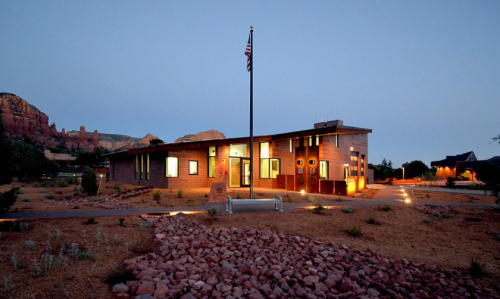
When one thinks of southwestern architecture, an image of earth tones, or adobe style homes with stucco walls can come to mind, basically a space rooted from the ground and designed to fit the needs of comfortable, simple living.
Many facets influence the style of architecture in the state. Frank Lloyd Wright stamped the southwest with his contemporary architecture like the glamorous Arizona Biltmore Resort in Phoenix, the prestigious Grady Gammage Memorial Auditorium in Tempe, and left a legacy of an award winning school of architecture, Taliesin in Scottsdale.
Now, Arizona architectural style is meshing with sustainable resources to enhance modern designs while preserving the environment.
“Sustainability is definitely the biggest trend in architecture right now,” said Professor Paul Reimer. He teaches a land ethics course and a design and fabrication course at the University of Arizona School of Architecture.
Reimer’s approach to teaching sustainability centers on the immediate surroundings, rainwater harvesting, energy conservation and cultural traditions.
“We are modifying our entire curriculum,” Reimer said on the importance of teaching students sustainability from the start of the five-year architecture-design program.
Reimer and his students recently took pieces from the historic UA’s Old Main and turned them into furniture. The furniture will be displayed in the newly renovated building later this spring.
“I think we are likely to go through a cultural shift,” said Reimer. He explains that for designing today’s architecture, it’s important to construct with a certain level of quality so there is something left for the next generation. “We have to learn how to value what we’ve learned from the last generation.”
Chris Lasch, a founder of thenaward-winning Aranda/Lasch architecture and design firm, says that architects understand the unique challenges of building in the desert.
“We want to make sure that the products we use in our designs, like flame retardant treatments, paints, glues, etcetera, aren’t made of harmful things that might leak into our indoor environments after construction or pollute the landscape after they eventually end up in a landfill,” said Lasch.
His firm based out of Tucson and New York but have projects worldwide. They create designs for buildings, furniture, and landscape.
“The desert has always been a place that has inspired experimentation with new forms of architecture and new ways of living, just check out Taliesin and Arcosanti for example. We like to think that we are a part of that tradition and the work we do here ends up influencing our projects in Miami, Africa, China and whatever comes next,” said Lasch.
An expert in creating sustainable designs in the Arizona Sonoran Desert is Lance Enyart of LEA Architects. His firm has won several awards in sustainability and follow the Coconino Sustainable Building Program which is an effort for residents in the Coconino County to build sustainable properties. Their mission is to educate, support, encourage and help develop sustainable building practices.
“Moreover we are focused on form and function,” said Enyart. “It’s part of being a good architect, is to be sustainable.”
The family-ran firm has projects throughout Arizona, from fire stations, military bases, residential, and commercial spaces.
Aside from building something that preserves the environment, the goal is to have a beautiful building, said Enyart.
Enyart was the first person to graduate in a master’s program from Arizona State University in Solar Architecture in the 70’s. Today, he is a pioneer in creating a space that uses passive orientation, a technique use to warm and heat a space.
Living in the desert enables him to study materials that are already found throughout the desert. Doing so provides a unique style to the southwest.
He explained that the purity of passive design; to deny the sun and allow it in when you do, is absolutely perfect to enhance the aesthetic of a space.
Examples of leading sustainable buildings in the southwest:
These southwest sustainable buildings are classified modern
design and the use of geographical resources in an urban setting.
Located 70 miles north of Scottsdale, the Cosanti Foundation is a non-profit program that supports sustainable building. According to its website their goal is to educate design professionals and the public the architectural concepts of using resourcefulness in an urban environment. Inside Arcosanti is a multi-structure building that offers tours, food, and lodging
Located in Scottsdale, the Frank Lloyd Wright School of Architecture is a leading architecture school in the nation. With their motive to preserve work from Wright, the school is built on 500 acres on the South foothills of the McDowell Mountains. According to the website, the space is used to engage students with the natural environment, to better understand natural, desert architecture.
The Sedona Fire District Communications Center
The station, to be built by LEA Architects is currently in the process of being built. The building uses a more progressive side of architecture by preserving the landscape of Sedona while making a productive space for the Sedona Fire District offering a space that will serve as the communications and dispatch headquarters for all of Northern Arizona. The Keep Sedona Beautiful Architecture
To see more sustainable projects by LEA architects. Click here.
Britt Theodora is a reporter for Arizona Sonora News, a service from the School of Journalism with the University of Arizona. Contact her at [email protected]
Click here for a Word version of this story and high-resolution photos.


